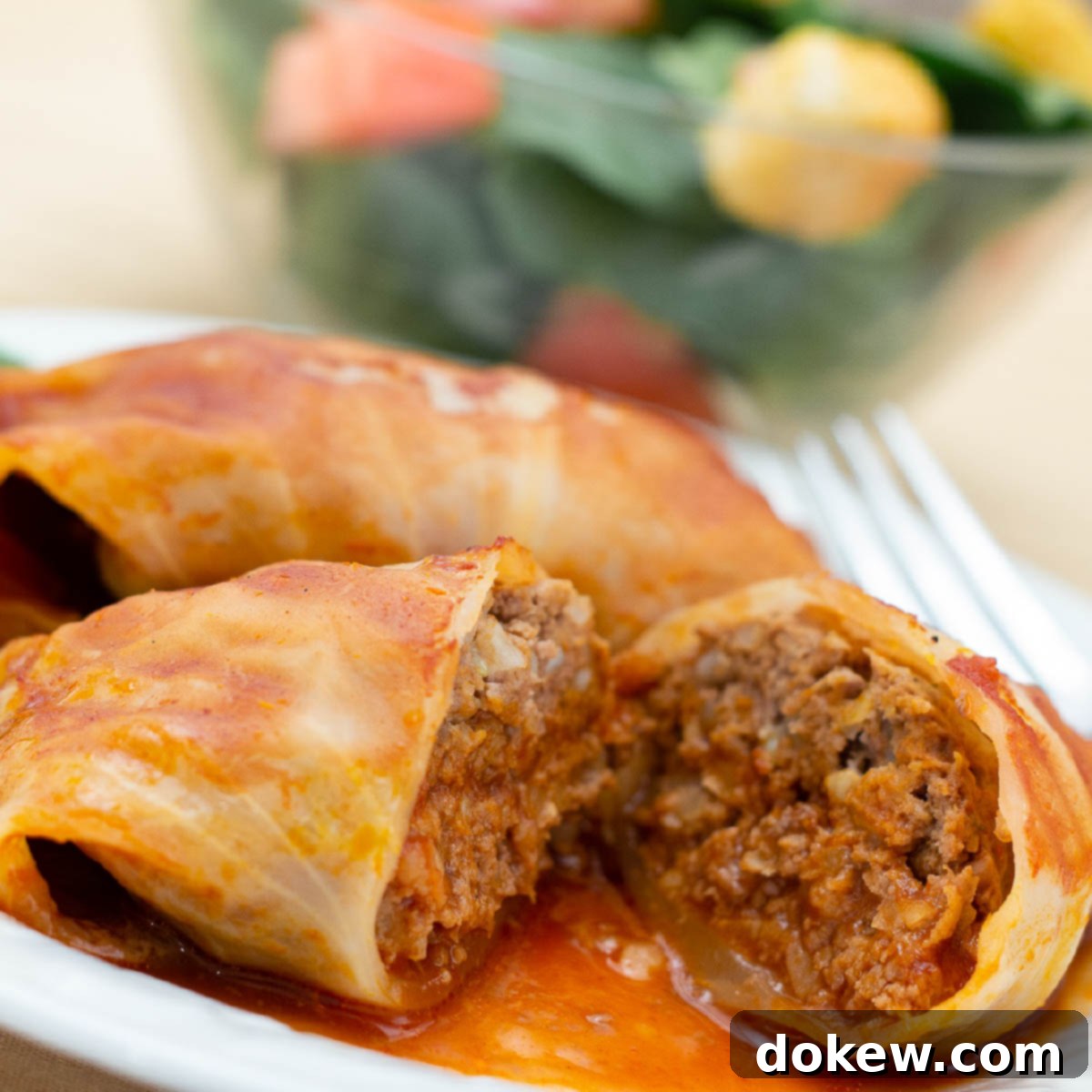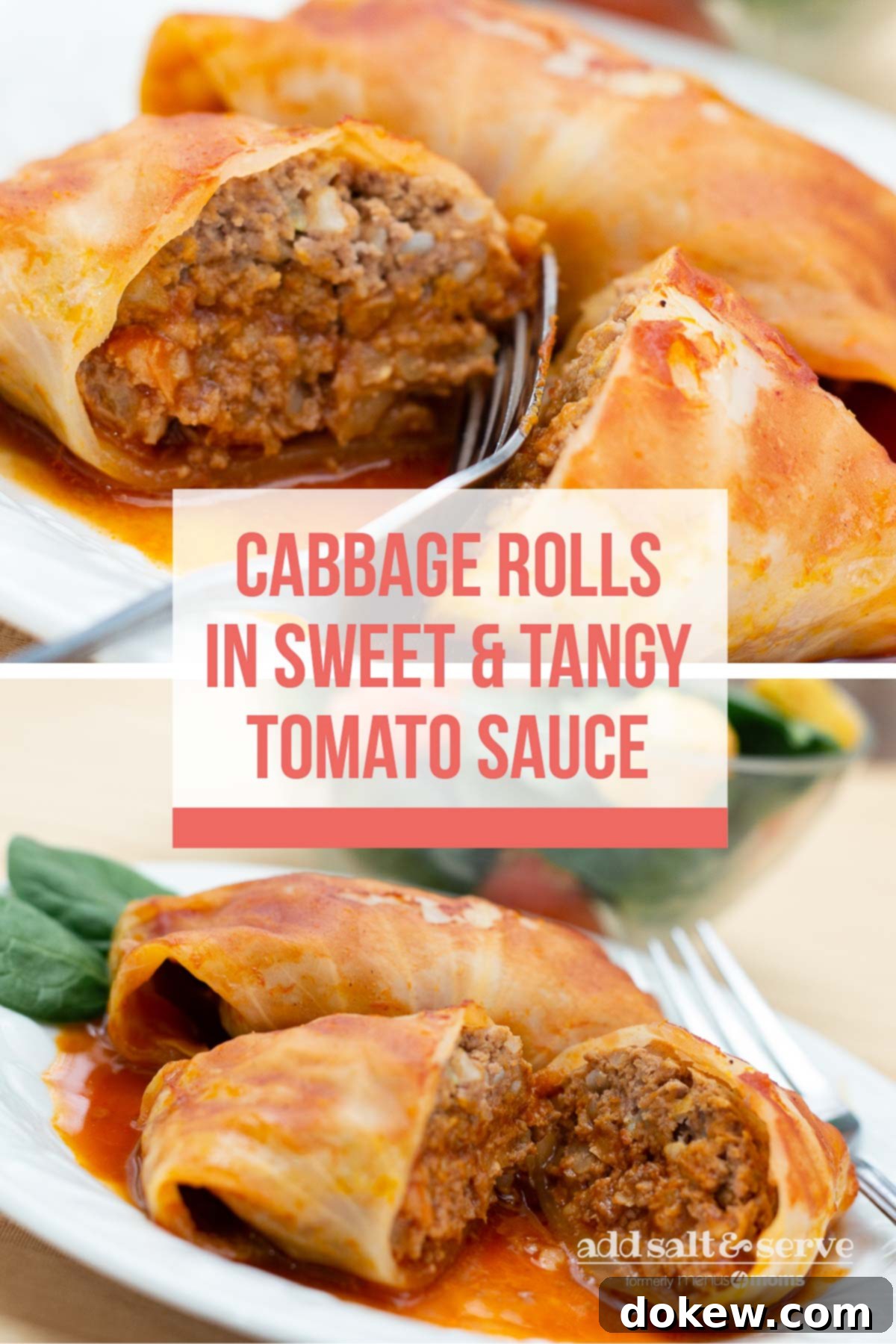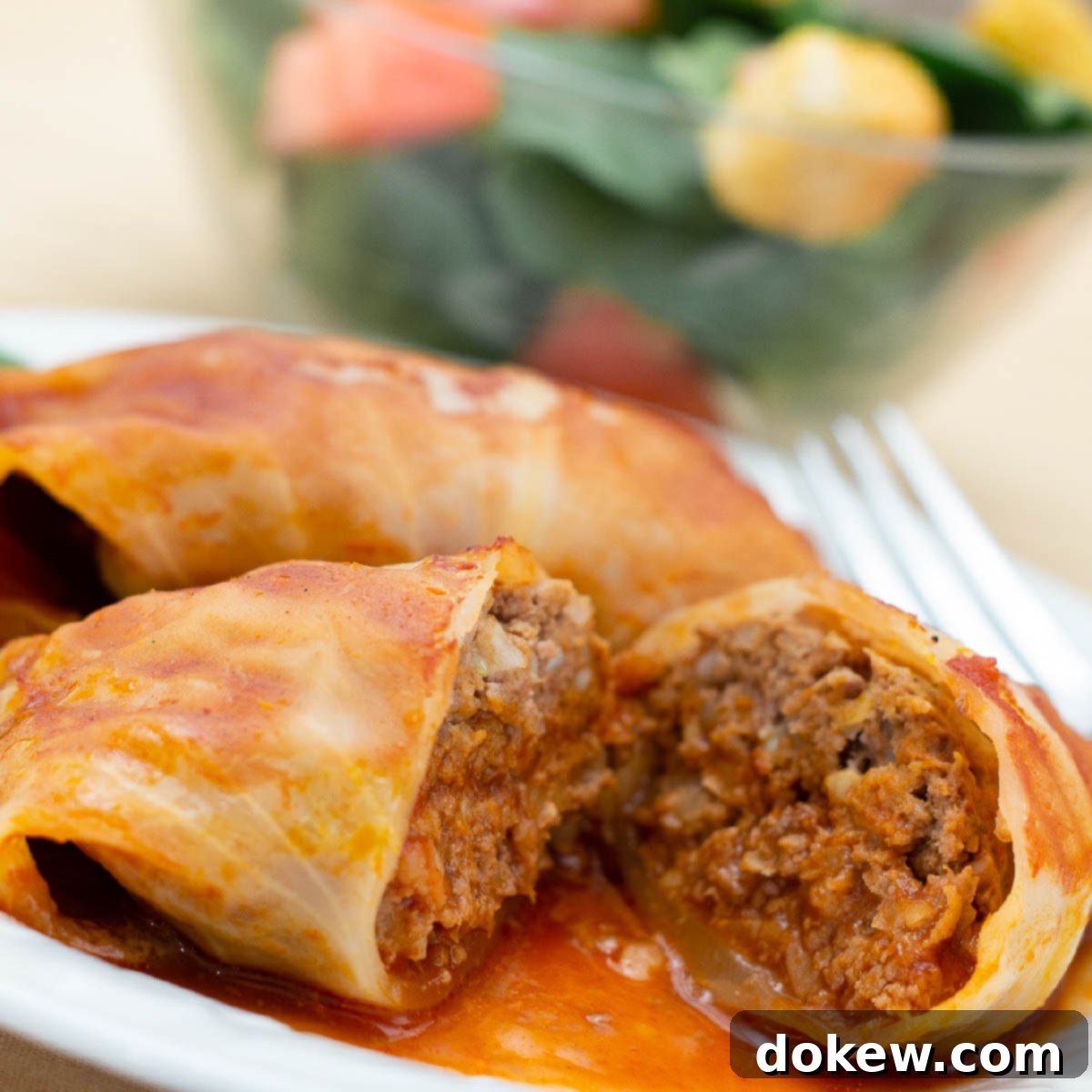Hearty & Easy Cabbage Rolls with Sweet and Tangy Tomato Sauce: Your Ultimate Comfort Food Guide
There’s something incredibly comforting about a plate of homemade cabbage rolls. Tender cabbage leaves, generously filled with a seasoned mixture of ground beef and rice, all slow-cooked or baked to perfection in a rich, sweet, and tangy tomato sauce. Often compared to savory mini-meatloaves, these delightful parcels are a staple in many cuisines and for good reason: they’re satisfying, flavorful, and remarkably versatile. This recipe offers a straightforward path to creating these classic comfort food favorites, perfect for cozy family dinners or convenient meal prep.
Whether you’re looking for a hearty weeknight dinner solution or a dish that can gently simmer while you go about your day, these cabbage rolls deliver. They can be effortlessly prepared in the oven, yielding beautifully browned tops and a deeply concentrated sauce, or for ultimate hands-off cooking, slow-cooked in a crockpot until every component is infused with deliciousness. This adaptability makes them an ideal choice for busy households or anyone looking to avoid heating up their kitchen on a warm day.

[feast_advanced_jump_to]
⏲️ Prep and Cooking Time: Making Your Cabbage Rolls Efficiently
One of the beauties of this cabbage roll recipe is its flexibility in cooking time and method. You’ll need approximately 30 minutes of active prep time to get the filling mixed, the cabbage leaves ready, and the rolls assembled. This active time involves blanching the cabbage, mixing the meat and rice filling, and then rolling the individual parcels. While 30 minutes is a general estimate, it can be quicker if you’re an experienced cook or if you have some helpers in the kitchen!
The cooking time, however, is where the main difference lies depending on your chosen method:
- Oven Baking: If you opt for the traditional oven method, your cabbage rolls will bake for about 75 minutes at 350°F (175°C). This allows the flavors to meld beautifully, the cabbage to become incredibly tender, and the sauce to thicken into a delectable glaze.
- Slow Cooker (Crockpot): For a truly hands-off approach, the slow cooker is your best friend. After assembling, simply transfer the rolls to your crockpot and cook on low for 4-6 hours. The exact time may vary slightly based on the size and temperature settings of your specific appliance, so keep an eye on them towards the end of the cooking window. The slow cooker method results in ultra-tender rolls and a deeply flavored sauce.
Considering both prep and cook time, you’re looking at a total commitment of roughly 1 hour 45 minutes to 2 hours for oven-baked rolls, or 4.5 to 6.5 hours for slow-cooked versions. This makes them perfect for weekend cooking, where they can simmer gently, or for busy weekdays if you get the prep done ahead of time or utilize the slow cooker’s magic.
🥘 Essential Ingredients for Flavorful Cabbage Rolls
Crafting the perfect cabbage roll relies on a harmonious blend of simple yet impactful ingredients. Each component plays a vital role in creating the rich texture and signature sweet and tangy flavor profile of this dish. Here’s what you’ll need:
- Cabbage Leaves: The star of the show! You’ll need a large head of green cabbage, preferably one with large, pliable leaves that are easy to separate and roll. Aim for approximately 12 large leaves.
- Rice: Cooked rice acts as a binder and adds substance to the filling. White rice is commonly used, but you could experiment with brown rice for a nuttier flavor and added fiber. Ensure it’s cooked before mixing with the other filling ingredients.
- Egg: A single beaten egg helps to bind the ground beef and rice mixture together, ensuring the filling stays intact during cooking and creating a more cohesive texture.
- Milk: A small amount of milk adds moisture to the filling, keeping the ground beef tender and preventing it from becoming too dry. Any type of dairy or non-dairy milk can be used.
- Onion: Finely diced onion provides a foundational aromatic flavor that permeates the entire dish. Its sweetness balances the savory notes of the beef.
- Ground Beef: Lean ground beef (80/20 or 85/15) is ideal for this recipe, offering excellent flavor without excessive grease. You could also experiment with a mix of ground beef and pork, or even ground turkey for a lighter option.
- Salt: Essential for seasoning the filling and enhancing all the other flavors. Adjust to your personal taste.
- Garlic (Minced): Fresh minced garlic adds a pungent, savory depth that is indispensable in many comfort food recipes.
- Garlic Powder: Provides a consistent garlic flavor throughout the filling, complementing the fresh garlic.
- Onion Powder: Similar to garlic powder, onion powder reinforces the onion flavor profile and ensures an even distribution of taste.
For the Sweet & Tangy Sauce: This is where the magic happens, transforming plain tomato sauce into a vibrant, irresistible glaze.
- Tomato Sauce (15 oz can): The base of our flavorful sauce. Choose a good quality plain tomato sauce.
- Brown Sugar: Adds a crucial sweetness that balances the acidity of the tomatoes and lemon juice, creating that signature sweet note.
- Lemon Juice: Provides the “tangy” element, brightening the sauce and cutting through the richness of the beef. Freshly squeezed is always best.
- Worcestershire Sauce: A secret weapon for umami depth and a subtle savory complexity that elevates the entire sauce.
🌾 Adaptations for Dietary Restrictions: Enjoy Cabbage Rolls Your Way
One of the great things about this cabbage roll recipe is how adaptable it is to various dietary needs and preferences. With a few simple tweaks, almost anyone can enjoy this delicious comfort food.
- Gluten-Free: This recipe is naturally gluten-free! The main ingredient to watch out for is Worcestershire sauce, as some brands contain gluten. Always check the label to ensure you’re using a certified gluten-free Worcestershire sauce. Most major brands now offer a GF version, so it’s usually an easy swap. The rice, cabbage, meat, and other seasonings are all typically gluten-free.
- Dairy-Free: If you’re avoiding dairy, simply swap the regular milk in the filling for a dairy-free alternative like unsweetened almond milk, soy milk, or oat milk. The small amount used primarily for moisture means the flavor impact will be minimal.
-
Vegetarian or Vegan Options: For a plant-based version, you can easily substitute the ground beef.
- For Vegetarian: Use a plant-based ground meat alternative (e.g., Impossible, Beyond Meat) or a hearty mixture of cooked lentils and finely chopped mushrooms (sautéed first for moisture removal and flavor development). You can also include finely shredded carrots or zucchini for added nutrients and texture. For binding, a “flax egg” (1 tbsp ground flaxseed mixed with 3 tbsp water, let sit for 5 minutes) can replace the chicken egg.
- For Vegan: Combine the vegetarian substitutions above, ensuring all other ingredients like milk and Worcestershire sauce are also vegan-friendly (there are vegan Worcestershire sauces available, often made with soy sauce).
-
Low-Carb Options: If you’re looking to reduce carbohydrate intake, the main adjustment will be the rice.
- Cauliflower Rice: You can substitute the cooked rice with an equal amount of cooked and cooled cauliflower rice. Ensure the cauliflower rice is thoroughly drained after cooking to prevent excess moisture in the filling.
- Reduced Rice: Alternatively, you can simply reduce the amount of rice or omit it entirely, increasing the ground beef slightly to maintain volume. The rolls will have a more “meatloaf” like texture in this case.
- Sodium Control: If you’re monitoring sodium intake, you can adjust the added salt in the filling and choose low-sodium tomato sauce and Worcestershire sauce. Herbs and spices like dried parsley, thyme, or paprika can enhance flavor without adding extra sodium.
Remember to always double-check labels for any hidden ingredients, especially when dealing with allergies or specific dietary requirements. These adaptations ensure that the deliciousness of cabbage rolls can be enjoyed by everyone at your table.
📋 Step-by-Step Instructions for Perfect Cabbage Rolls
Creating these delightful cabbage rolls is a straightforward process when broken down into manageable steps. Follow these instructions carefully to ensure tender cabbage, a perfectly seasoned filling, and that irresistible sweet and tangy sauce.
Prepping the Cabbage Leaves
- Boil Water: Fill a large pot (one big enough to submerge a head of cabbage or several leaves) halfway with water. Bring it to a rapid boil over high heat. Add a pinch of salt to the water, if desired, to lightly season the cabbage.
- Prepare Cabbage: Carefully remove the core from the bottom of the cabbage head with a sharp knife. This will make it easier to peel off the leaves.
- Blanch Leaves: Gently add the individual cabbage leaves (or the whole cored head, removing outer leaves as they soften) to the boiling water. Cook for approximately 3 minutes, or until the leaves are pliable and slightly tender. You want them soft enough to roll without tearing, but not overly mushy.
- Cool and Drain: Using tongs, carefully remove the blanched cabbage leaves from the pot. Drain them thoroughly and set them aside on a plate or cutting board to cool slightly. Once cool enough to handle, use a paring knife to carefully shave down any thick veins at the base of each leaf. This makes them even easier to roll and eat.
Preparing the Filling
- Combine Filling Ingredients: In a large mixing bowl, combine the cooked rice, beaten egg, milk, finely diced onion, ground beef, salt (to taste), minced garlic, garlic powder, and onion powder.
- Mix Thoroughly: Using your hands (or a sturdy spoon), mix all the ingredients together until they are well combined. Be careful not to overmix, as this can make the ground beef tough. The goal is to ensure all seasonings and binders are evenly distributed throughout the meat and rice.
Assembling the Cabbage Rolls
- Portion Filling: Lay a blanched cabbage leaf flat on a clean surface. Place an equal amount (about 2-3 tablespoons, depending on leaf size) of the meat mixture at the stem end of each cabbage leaf.
- Roll Tightly: Fold the bottom edge of the cabbage leaf over the filling. Then, fold in the sides of the leaf towards the center. Finally, roll the cabbage leaf tightly from the bottom up to create a compact, cylindrical roll. The tighter they are, the less likely they are to unravel during cooking. Repeat this process with all the remaining cabbage leaves and filling.
- Arrange in Baking Pan: Place the finished cabbage rolls, seam-side down, snugly next to each other in a 9×13-inch baking pan. This tight arrangement helps them hold their shape and keeps them submerged in the sauce.
Making and Adding the Sauce
- Mix Sauce Ingredients: In a separate bowl, whisk together the tomato sauce, brown sugar, lemon juice, and Worcestershire sauce until thoroughly combined and smooth. Taste and adjust sweetness or tanginess if desired.
- Pour Over Rolls: Evenly pour the prepared sauce over the arranged cabbage rolls in the baking pan, ensuring they are mostly covered.
Cooking the Cabbage Rolls (Oven or Crockpot)
- For Oven Baking: Cover the baking pan tightly with aluminum foil.
- Bake: Preheat your oven to 350°F (175°C). Bake the covered cabbage rolls for 75 minutes. The foil helps steam the cabbage and cook the meat thoroughly while keeping the rolls moist.
- For Slow Cooker Cooking: After assembling and pouring the sauce, place the baking pan (or transfer rolls directly) into your slow cooker. Cook on the LOW setting for 4-6 hours, or until the cabbage is very tender and the internal temperature of the meat reaches 160°F (71°C).
Once cooked, carefully remove the pan from the oven or crockpot. Let the cabbage rolls rest for a few minutes before serving. Enjoy your delicious homemade comfort food!
💭 Tips for Perfect Cabbage Rolls Every Time
Achieving perfectly tender, flavorful cabbage rolls is easier with a few expert tips. These insights will help you navigate common challenges and elevate your dish from good to outstanding.
- Choosing the Right Cabbage: The success of your rolls starts with the cabbage. Look for a large, firm head of green cabbage with bright, crisp leaves. Larger leaves are much easier to work with when rolling, as they can hold more filling and are less prone to tearing. Avoid heads with wilted or damaged outer leaves.
-
Blanching Cabbage Effectively: Don’t skip the blanching step! It’s crucial for softening the cabbage leaves, making them pliable and easy to roll without cracking. When blanching, remember to:
- **Core the Cabbage First:** Removing the core helps the leaves detach more easily after blanching.
- **Blanch in Batches:** If your pot isn’t large enough for the whole head, blanch a few leaves at a time.
- **Shave Down Thick Veins:** Once blanched and cool enough to handle, use a paring knife to thin out the tough, thick central rib of each leaf. This prevents stiffness in the finished roll and makes them easier to eat.
-
Ground Beef Texture: Raw vs. Pre-cooked: The choice between raw or pre-cooked ground beef significantly impacts the final texture of your filling.
- **Raw Ground Beef (Recommended for this recipe):** Using raw ground beef in the filling, as directed in this recipe, results in a tighter, more cohesive “meatloaf-like” texture. The meat cooks slowly within the cabbage leaf, releasing its juices into the rice and cabbage, creating a rich, integrated flavor.
- **Pre-cooked Ground Beef:** If you prefer a looser, more crumbly texture to the filling, you can lightly brown the ground beef before mixing it with the other ingredients. This can also reduce some of the fat content if you drain it. However, be aware that the rolls may not hold together as tightly and the overall flavor might be slightly less integrated.
- Rolling Technique: Practice makes perfect! Aim for tight, compact rolls. Start by folding the bottom edge over the filling, then fold in the sides, and finally roll upwards. A tight roll ensures the filling stays put and the cabbage cooks evenly around it. If a leaf tears slightly, you can often patch it with a smaller piece of cabbage or simply roll it as best as you can and place it seam-side down in the pan.
- Don’t Forget the Sauce: The sweet and tangy tomato sauce is what truly defines these cabbage rolls. Don’t be afraid to taste and adjust the sauce ingredients (brown sugar, lemon juice, Worcestershire) to your preference. Some like it sweeter, others tangier.
-
Make Ahead & Freezing: Cabbage rolls are fantastic for meal prep!
- **To Make Ahead:** Assemble the rolls and place them in the baking dish. Prepare the sauce and pour it over. Cover tightly and refrigerate for up to 24-48 hours before baking or slow cooking.
- **To Freeze (Uncooked):** Assemble the rolls and sauce in a freezer-safe baking dish. Cover tightly with plastic wrap and then foil. Freeze for up to 3 months. Thaw in the refrigerator overnight before baking as directed.
- **To Freeze (Cooked):** Fully cooked and cooled cabbage rolls can also be frozen in an airtight container or freezer bag for up to 3 months. Thaw and reheat gently in the oven or microwave until warmed through.
- Crockpot Considerations: When using a slow cooker, ensure your rolls are snuggled tightly to prevent them from unraveling. The cooking time on low (4-6 hours) is a guideline; older or smaller slow cookers might take longer, while newer, more powerful ones might be faster.
With these tips, you’re well on your way to making delicious cabbage rolls that will impress everyone at your table!
Recipe: Classic Cabbage Rolls with Sweet and Tangy Tomato Sauce

Cabbage Rolls with Sweet and Tangy Tomato Sauce
Ingredients
- 12 leaves green cabbage
- 1 cup cooked rice
- 1 egg, beaten
- ¼ cup milk
- 1 small onion, finely diced
- 1 lb. ground beef
- Salt to taste
- 4 cloves garlic, minced
- 1 tablespoon garlic powder
- 1 tablespoon onion powder
Sauce:
- 15 oz can tomato sauce
- 3 tablespoon brown sugar
- 3 tablespoon lemon juice
- 3 tablespoon Worcestershire sauce
Instructions
- Fill a large pot halfway full with water and bring to a rapid boil.
- Add cabbage leaves and cook for 3 minutes, drain, and set aside to cool slightly.
- In a large bowl combine rice, egg, milk, onion, ground beef, and seasonings; mix well.
- Place an equal amount of the meat mixture in each cabbage leaf and roll up, tucking in ends and making them as tight as possible.
- Place rolls in a 9 x 13 inch baking pan.
- Mix together sauce ingredients and pour over the rolls.
- Cover tightly with aluminum foil.
- Bake at 350°F for 75 minutes.
Notes
The ground beef can be precooked if you prefer a looser texture to the filling. Starting with raw ground beef will result in a tighter loaf-type dish, where starting with cooked ground beef will result in a more crumbly and less compact dish.
To cook in the crockpot, follow the instructions to assemble the cabbage rolls, then place them into the crockpot. Mix the ingredients for the sauce and pour over the cabbage rolls. Cook for 4-6 hours on low (adjust depending on the size and temperature of your appliance).
This recipe is naturally gluten-free as long as your Worcestershire sauce is GF, so check your labels.
Nutrition per serving
Carbohydrates: 13 g
Protein: 10 g
Fat: 3 g
Sodium: 362 mg
Fiber: 1 g
Sugar: 6 g
Net Carbohydrates: 12 g
🥗 Perfect Side Dishes to Serve with Cabbage Rolls
Cabbage rolls are a complete meal in themselves, offering protein, grains, and vegetables all wrapped into one delicious package. However, pairing them with the right side dishes can elevate your dining experience and balance the flavors beautifully. Here are some excellent options:
- Crisp Green Salad: A fresh, crisp green salad with a light vinaigrette is a fantastic counterpoint to the rich, hearty cabbage rolls. The freshness and acidity of the salad help to cleanse the palate and provide a lovely textural contrast. Think mixed greens, cherry tomatoes, cucumbers, and a simple lemon-herb dressing.
- Creamy Mashed Potatoes: While the rolls contain rice, mashed potatoes offer a different kind of comforting carb. Their creamy, smooth texture is wonderful for soaking up any extra sweet and tangy tomato sauce. Consider adding a touch of garlic or herbs to your mashed potatoes for extra flavor.
- Crusty Bread or Dinner Rolls: A warm, crusty baguette or soft dinner rolls are perfect for mopping up every last drop of that delicious sauce. Garlic bread is also an excellent choice, adding another layer of savory goodness.
- Steamed or Roasted Vegetables: If you want to boost your vegetable intake beyond the cabbage, consider simple steamed green beans, broccoli, or asparagus. Roasted root vegetables like carrots or parsnips can also add a touch of sweetness and earthiness that complements the rolls.
- Sour Cream or Yogurt: A dollop of sour cream or plain Greek yogurt served alongside the cabbage rolls adds a creamy, slightly tangy element that many people enjoy. It cools the palate and adds another dimension of flavor, especially if you like a little extra richness.
- Pickled Vegetables: For a bright, zesty contrast, a side of pickled cucumbers or other pickled vegetables can cut through the richness and add a refreshing crunch.
Choose one or two of these sides to create a well-rounded and satisfying meal that perfectly complements your homemade cabbage rolls.
📌 Pin This Recipe for Later!
Don’t let this incredible recipe slip away! Pin this image to your favorite recipe boards on Pinterest so you can easily find it whenever you’re craving a comforting, flavorful meal. These Sweet & Tangy Cabbage Rolls are destined to become a family favorite.

Frequently Asked Questions About Cabbage Rolls
1. What kind of cabbage is best for cabbage rolls?
For cabbage rolls, a large head of green cabbage is ideal. Look for one that feels heavy for its size and has pliable, intact outer leaves. The larger the leaves, the easier they will be to work with when rolling. Savoy cabbage can also work due to its tender leaves, but green cabbage is the traditional choice and holds up well to cooking.
2. Do I have to blanch the cabbage leaves before rolling?
Yes, blanching the cabbage leaves is a crucial step that you shouldn’t skip. Boiling them for a few minutes softens the leaves, making them much more flexible and easy to roll without tearing. It also mellows their strong raw cabbage flavor. If you try to roll raw cabbage, the leaves will likely crack and break.
3. Can I use different types of meat for the filling?
Absolutely! While ground beef is traditional, you can easily adapt the recipe with other ground meats. A mix of ground beef and pork (e.g., 50/50) adds extra richness and flavor. Ground turkey or chicken can be used for a lighter version, though they might result in a slightly drier filling, so consider adding a bit more moisture (like extra milk or a spoonful of tomato sauce) to compensate. For vegetarian options, plant-based ground meat substitutes or a mixture of cooked lentils and mushrooms work wonderfully.
4. How do I prevent my cabbage rolls from falling apart during cooking?
Several tips can help your rolls stay intact:
- Tight Rolling: Ensure you roll the cabbage leaves as tightly as possible, tucking in the sides securely.
- Seam-Side Down: Always place the finished rolls seam-side down in the baking dish or slow cooker.
- Snug Fit: Arrange the rolls snugly next to each other in the pan. This provides support and keeps them from unraveling.
- Don’t Overcook: While tender is good, extreme overcooking can sometimes make the cabbage too soft to hold the filling.
5. Can I prepare cabbage rolls ahead of time?
Yes, cabbage rolls are an excellent make-ahead dish! You can assemble the rolls and pour the sauce over them, then cover the baking dish tightly and refrigerate for up to 1-2 days before baking or slow cooking. This allows the flavors to meld even further. Simply add an extra 15-20 minutes to the baking time if cooking from cold, or an extra hour for slow cooking.
6. How do I store and reheat leftover cabbage rolls?
Leftover cabbage rolls should be stored in an airtight container in the refrigerator for up to 3-4 days. To reheat, you can either warm them gently in the microwave or, for best results, place them back in a baking dish, cover with foil, and heat in a preheated oven at 300°F (150°C) until warmed through, about 20-30 minutes.
7. What if my sauce is too thick or too thin?
If your sauce is too thick after cooking, you can thin it out by stirring in a little beef broth or water until it reaches your desired consistency. If it’s too thin, you can uncover the dish for the last 15-20 minutes of baking in the oven to allow some moisture to evaporate, or simmer it gently on the stovetop after removing the rolls (for slow cooker method) to reduce it slightly.
